FORD EXPLORER 1997 2.G Owners Manual
Manufacturer: FORD, Model Year: 1997, Model line: EXPLORER, Model: FORD EXPLORER 1997 2.GPages: 236, PDF Size: 2.43 MB
Page 141 of 236

TRAILER TOWING TABLE 4X4 AUTOMATIC TRANSMISSION
4.0 L 3.734,535
(10,000)0-2,540
(0-5,600)50
4.0 L 4.104,535
(10,000)0-2,540
(0-5,600)50
TRAILER TOWING TABLE AWD AUTOMATIC TRANSMISSION
GCWR (Gross Combined Weight Rating)/Trailer Weights
4-DOOR
5.0 L 3.734,990
(11,000)0-2,902
(0-6,400)50
NOTES:
- For high altitude operation, reduce GCW by 2% per 300 meters
(1,000 ft) elevation.
- For definition of terms and instructions on calculating your vehicle's
load, refer toLoading your vehiclein this chapter.
- Maximum trailer weights shown. The combined weight of the
completed towing vehicle and the loaded trailer must not exceed the
GCWR.
Calculating trailer loads
To determine the amount of weight
that your vehicle can carry:
²Obtain ratings from the Safety
Compliance Certification label
and the trailer towing
specifications in this chapter.
²Weigh your vehicle as you
customarily operate the vehicle
without cargo.
²Subtract the total weight of
passengers, driver and optional
equipment to determine the
total weight that your vehicle
can carry.
uno_calculating_towing
Driving
142
Page 142 of 236
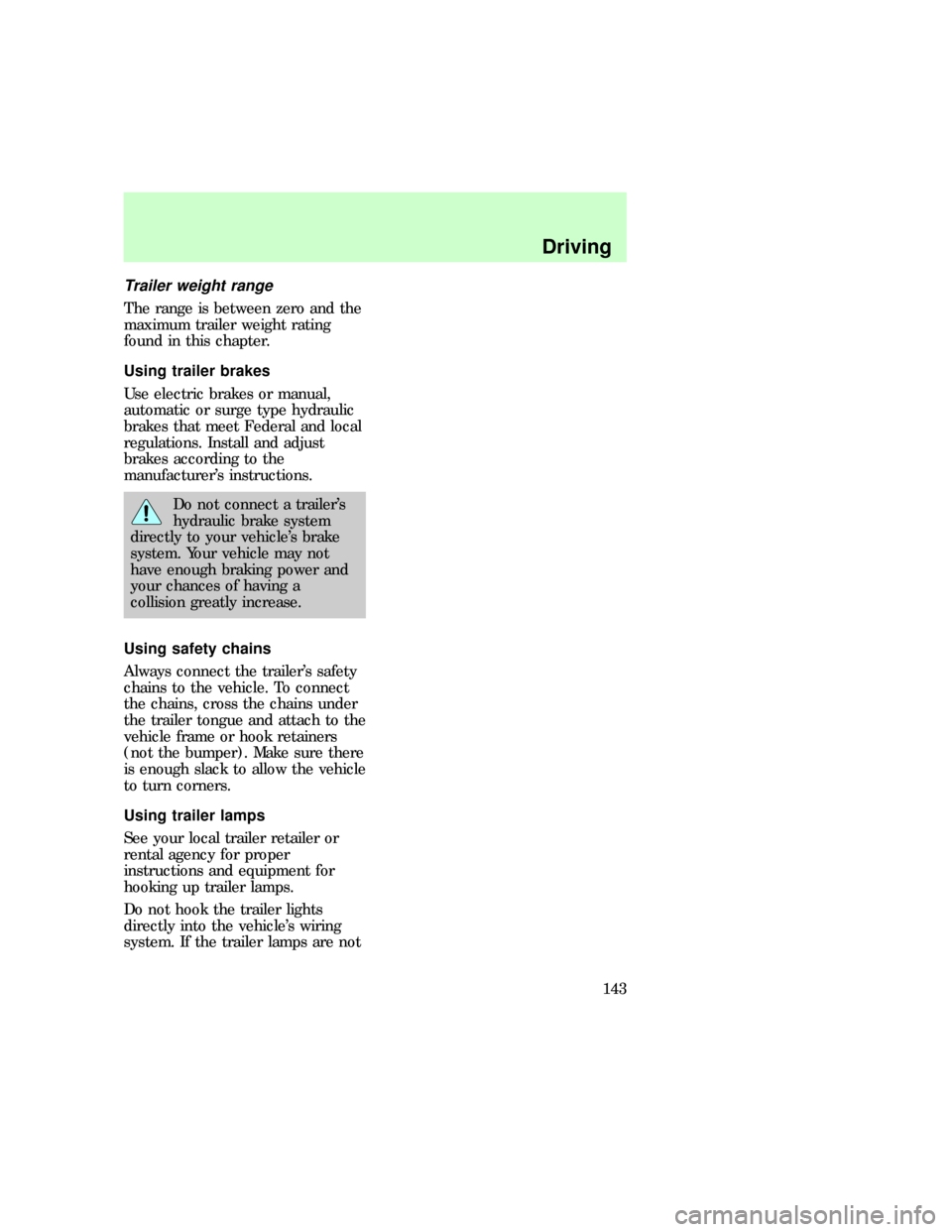
Trailer weight range
The range is between zero and the
maximum trailer weight rating
found in this chapter.
Using trailer brakes
Use electric brakes or manual,
automatic or surge type hydraulic
brakes that meet Federal and local
regulations. Install and adjust
brakes according to the
manufacturer's instructions.
Do not connect a trailer's
hydraulic brake system
directly to your vehicle's brake
system. Your vehicle may not
have enough braking power and
your chances of having a
collision greatly increase.
Using safety chains
Always connect the trailer's safety
chains to the vehicle. To connect
the chains, cross the chains under
the trailer tongue and attach to the
vehicle frame or hook retainers
(not the bumper). Make sure there
is enough slack to allow the vehicle
to turn corners.
Using trailer lamps
See your local trailer retailer or
rental agency for proper
instructions and equipment for
hooking up trailer lamps.
Do not hook the trailer lights
directly into the vehicle's wiring
system. If the trailer lamps are not
uno_brakes_trailer
uno_safety_chains
uno_lamps_trailer
Driving
143
Page 143 of 236

working properly, the warning
lights in the instrument cluster
may not work properly.
Using a hitch
Do not use hitches that:
²clamp onto the vehicle bumper
²attach to the axle.
Distribute the load so that only 10
to 15% of the total weight of the
trailer is on the tongue. tie down
the load so that it does not shift
and change the weight on the
hitch. Follow the towing
instructions of a reputable rental
agency.
Driving while towing a trailer
Do not drive faster than 70 km/h
(45 mph) while towing a 454 kg
(1000 lb) trailer. Do not drive
faster than 72 km/h (45 mph) with
any weight trailer while towing in
hilly terrain or on hot days.
Speed control (if equipped) may
not work properly while towing on
long, steep grades.
If driving with an automatic
transmission:
²use D or L rather than while
towing up or down steep hills
²anticipate stops and brake
gradually.
Towing behind another vehicle
Do not tow your vehicle behind
another vehicle, such as an RV,
unless front wheel dollies are used.
uno_hitch
uno_driving_towing
uno_towing_behind
Driving
144
Page 144 of 236

Your vehicle can not be flat towed
with all wheels on the ground.
Servicing while towing
If you tow a trailer for long
distances, your vehicle requires
more frequent service than a
vehicle not used for towing. Refer
to the ªService Guideº for more
information on maintenance
intervals.
Using a step bumper
The rear bumper is equipped with
an integral hitch and requires only
a ball with a ô inch shank
diameter. The bumper has a Class
II capability (1590 kg / 3500 lb
trailer weight and 159 kg / 350 lb
tongue weight).
Use a frame mounted weight
distributing hitch for trailers over
1590 kg (3500 lb).
Launching or retrieving a boat
When backing down a ramp during
boat launching or retrieval,
²Do not allow the static water
level to rise above the bottom
edge of the rear bumper and
²Do not allow waves to break
higher than 15 cm (six inches)
above the bottom edge of the
rear bumper.
Exceeding these limits may allow
water to enter critical vehicle
components, adversely affecting
driveability, emissions and
reliability.uno_servicing_while_towing
uno_step_bumper_towing
com_launch-retrieving_boat.01
uno_roof-rack_title
Driving
145
Page 145 of 236
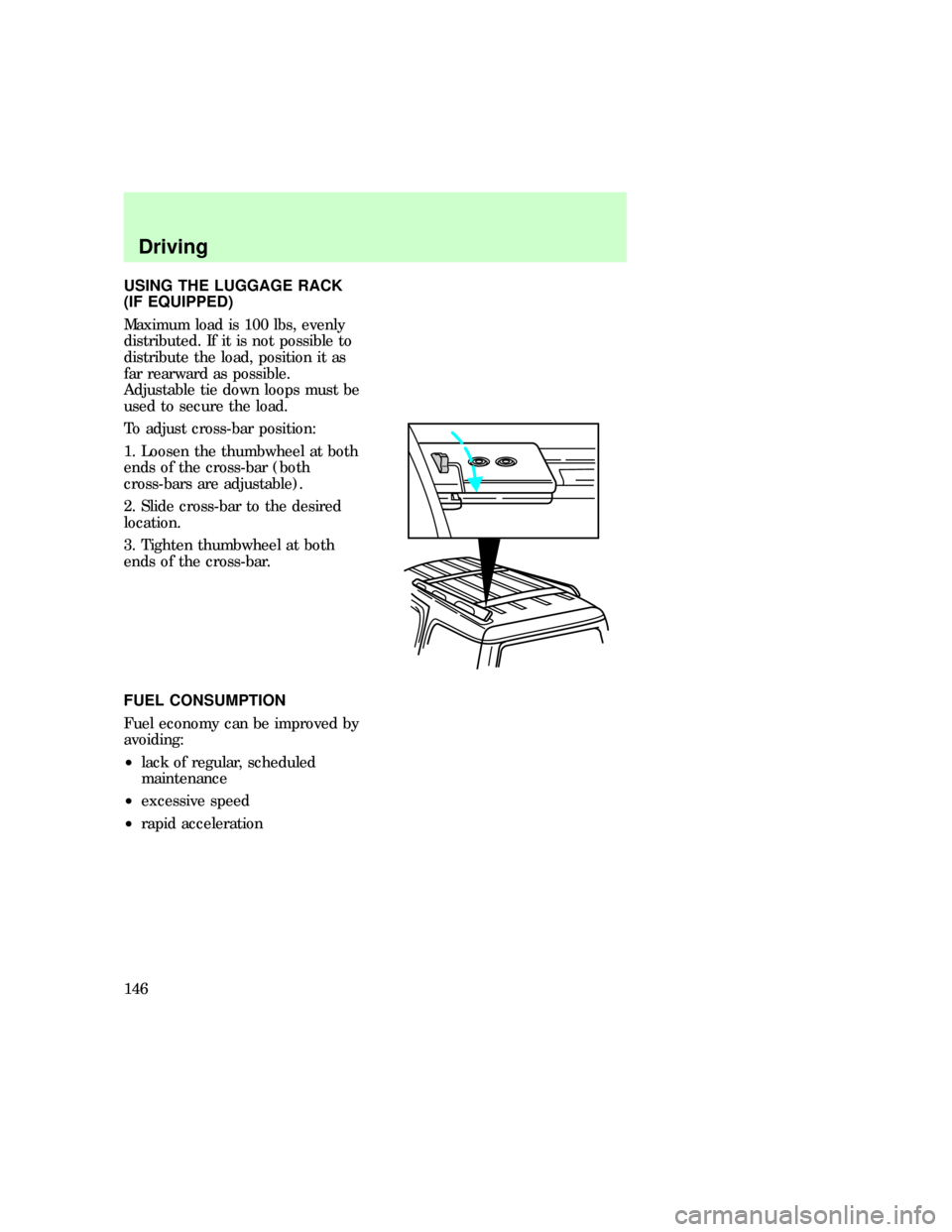
USING THE LUGGAGE RACK
(IF EQUIPPED)
Maximum load is 100 lbs, evenly
distributed. If it is not possible to
distribute the load, position it as
far rearward as possible.
Adjustable tie down loops must be
used to secure the load.
To adjust cross-bar position:
1. Loosen the thumbwheel at both
ends of the cross-bar (both
cross-bars are adjustable).
2. Slide cross-bar to the desired
location.
3. Tighten thumbwheel at both
ends of the cross-bar.
FUEL CONSUMPTION
Fuel economy can be improved by
avoiding:
²lack of regular, scheduled
maintenance
²excessive speed
²rapid acceleration
com_fuel_consumption.01
Driving
146
Page 146 of 236
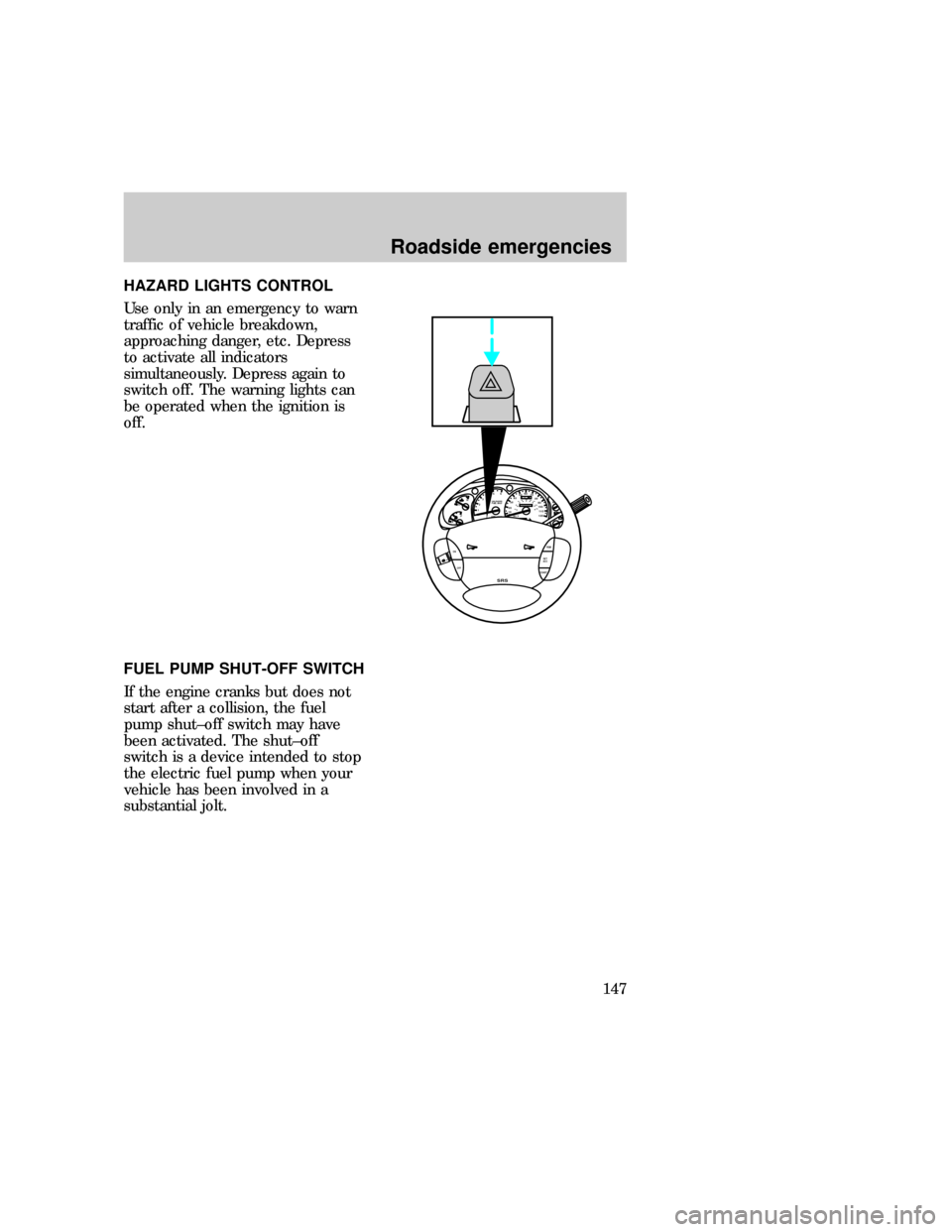
HAZARD LIGHTS CONTROL
Use only in an emergency to warn
traffic of vehicle breakdown,
approaching danger, etc. Depress
to activate all indicators
simultaneously. Depress again to
switch off. The warning lights can
be operated when the ignition is
off.
FUEL PUMP SHUT-OFF SWITCH
If the engine cranks but does not
start after a collision, the fuel
pump shut±off switch may have
been activated. The shut±off
switch is a device intended to stop
the electric fuel pump when your
vehicle has been involved in a
substantial jolt.
0P RND21
UNLEADED
FUEL ONLY
RPM x 100012345
6H
C
F
E
RSM
SET
ACC
COAST OFF ON
SRS
- +H
H
L L020
1030405060
70
80
90
110
120000000oooo
km/h10020406080100
120
140
160
180
uno_hazard_switch uno_fuel_shut-off
Roadside emergencies
147
Page 147 of 236
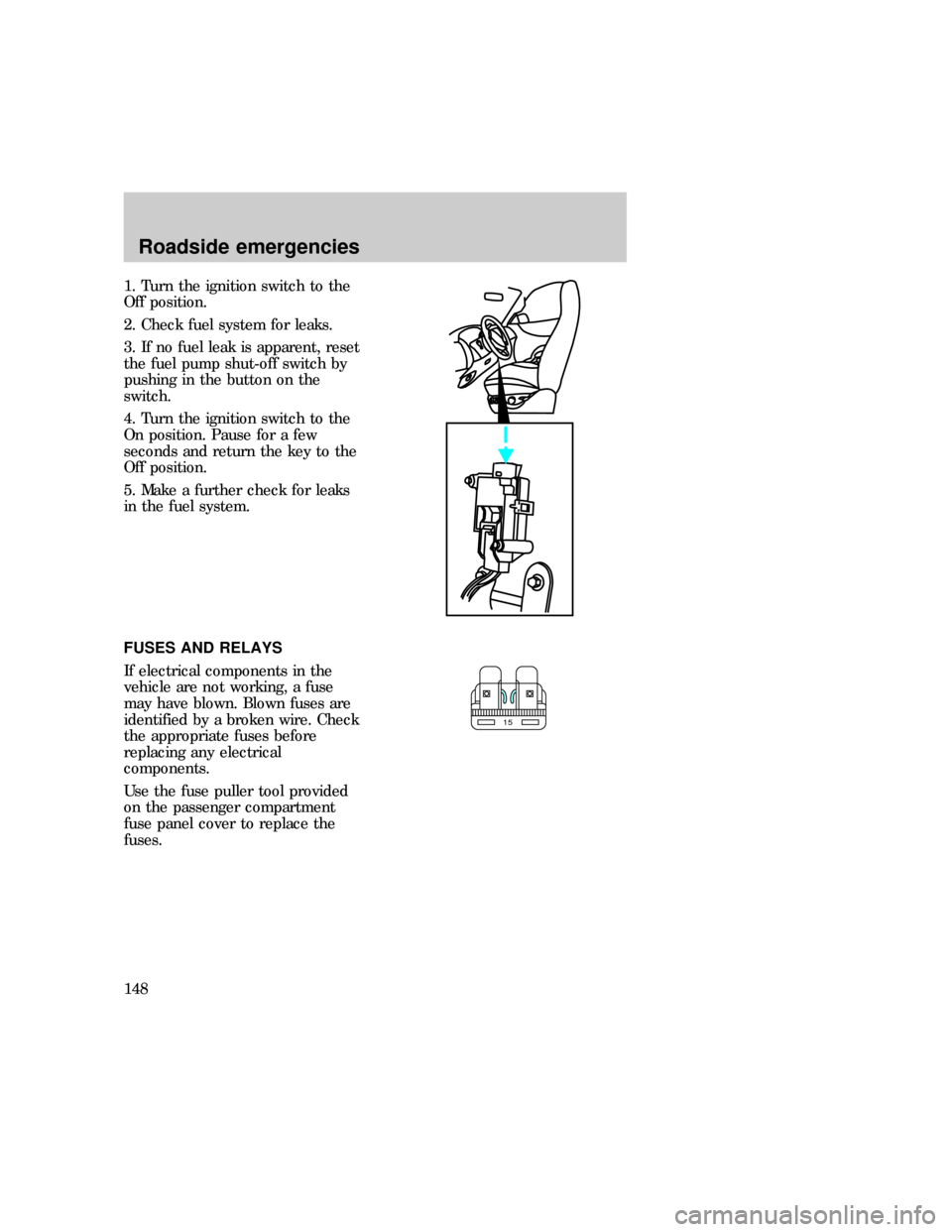
1. Turn the ignition switch to the
Off position.
2. Check fuel system for leaks.
3. If no fuel leak is apparent, reset
the fuel pump shut-off switch by
pushing in the button on the
switch.
4. Turn the ignition switch to the
On position. Pause for a few
seconds and return the key to the
Off position.
5. Make a further check for leaks
in the fuel system.
FUSES AND RELAYS
If electrical components in the
vehicle are not working, a fuse
may have blown. Blown fuses are
identified by a broken wire. Check
the appropriate fuses before
replacing any electrical
components.
Use the fuse puller tool provided
on the passenger compartment
fuse panel cover to replace the
fuses.
15
uno_fuses_relays_title
Roadside emergencies
148
Page 148 of 236
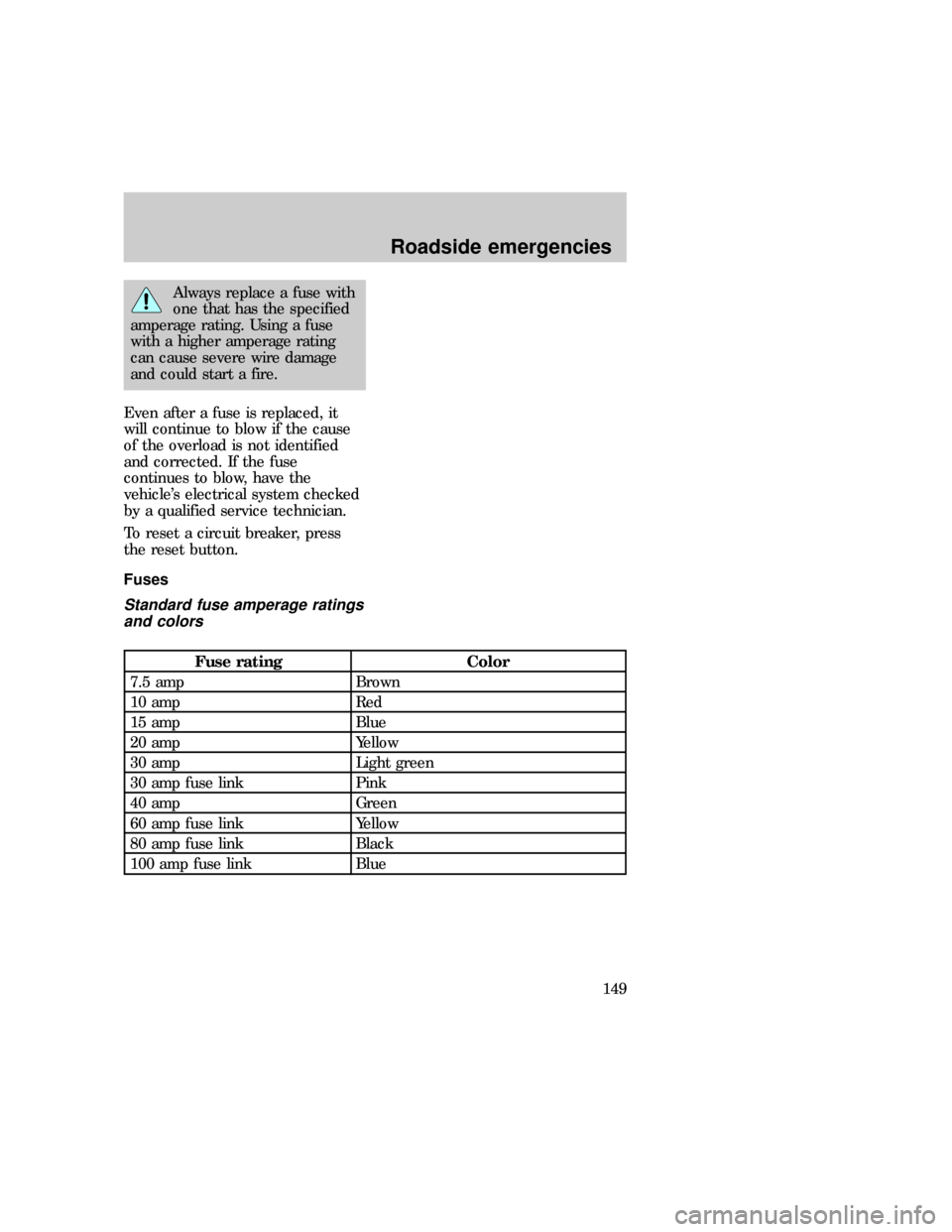
Always replace a fuse with
one that has the specified
amperage rating. Using a fuse
with a higher amperage rating
can cause severe wire damage
and could start a fire.
Even after a fuse is replaced, it
will continue to blow if the cause
of the overload is not identified
and corrected. If the fuse
continues to blow, have the
vehicle's electrical system checked
by a qualified service technician.
To reset a circuit breaker, press
the reset button.
Fuses
Standard fuse amperage ratings
and colors
Fuse rating Color
7.5 amp Brown
10 amp Red
15 amp Blue
20 amp Yellow
30 amp Light green
30 amp fuse link Pink
40 amp Green
60 amp fuse link Yellow
80 amp fuse link Black
100 amp fuse link Blue
uno_fuses_title
uno_color_chart
Roadside emergencies
149
Page 149 of 236
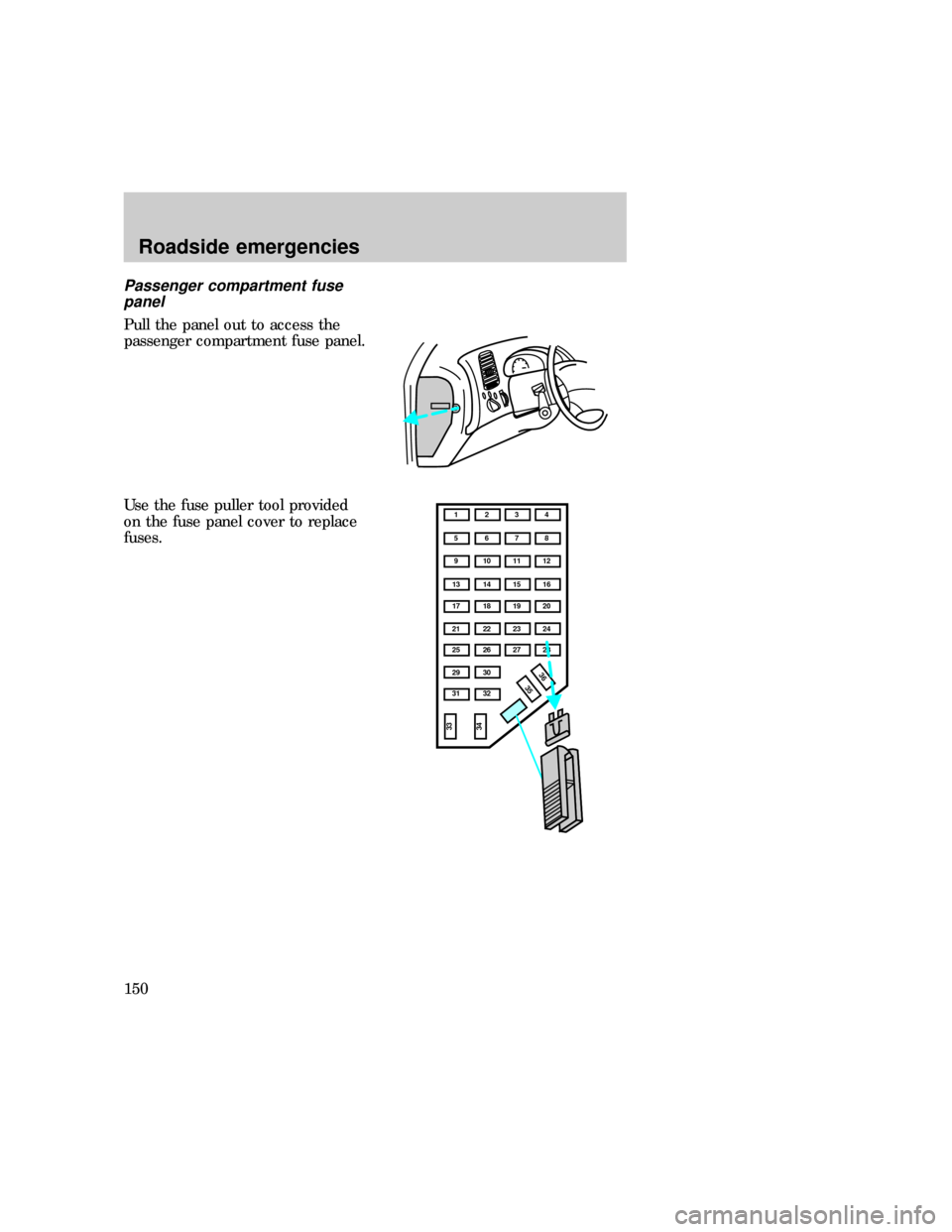
Passenger compartment fuse
panel
Pull the panel out to access the
passenger compartment fuse panel.
Use the fuse puller tool provided
on the fuse panel cover to replace
fuses.
1 234
5 678
9 101112
13 14 15 16
17 18 19 20
21 22 23 24
25 26
29 30
35 3631 32
33
34
27 28
uno_passenger_comp_fuses
Roadside emergencies
150
Page 150 of 236

Number Fuse Amperage
RatingCircuits Protected
1 7.5 amp Power mirror, power
antenna
2 7.5 amp High-mount brakelamp
3 15 amp Parking lamp,
instrument cluster
gauges
4 10 amp Left headlamp, lamp
out warning
5 10 amp OBD system
6 7.5 amp Air bag system, blower
relay, EATC
7 7.5 amp Illumination switches
8 10 amp Right headlamp, fog
lamp system, DRL,
lamp out warning
9 10 amp EATC system, seat
memory, message
center, cellular phone,
autolamps
10 7.5 amp EATC system, rear
blower, speed control,
GEM system, brake
interlock, overhead
console, automatic
ride control, lamp out
warning
11 7.5 amp Warning lamps,
autolamp
12 10 amp Front washer, rear
washer & wiper
Roadside emergencies
151